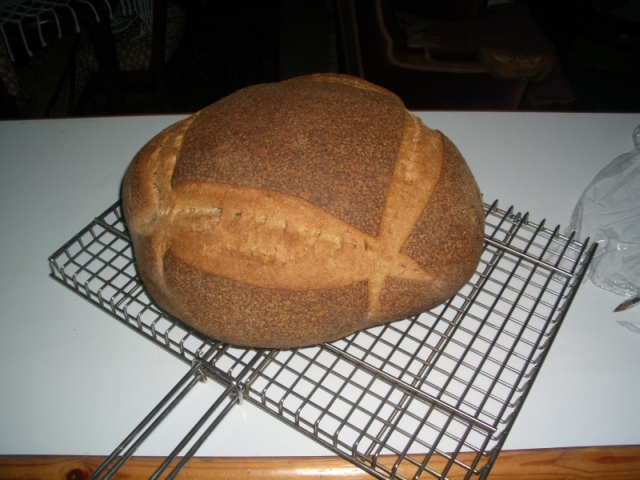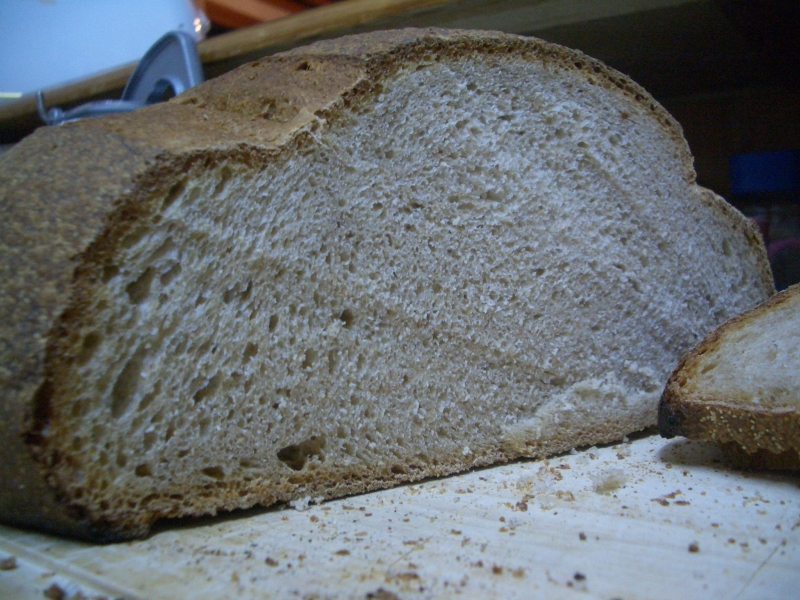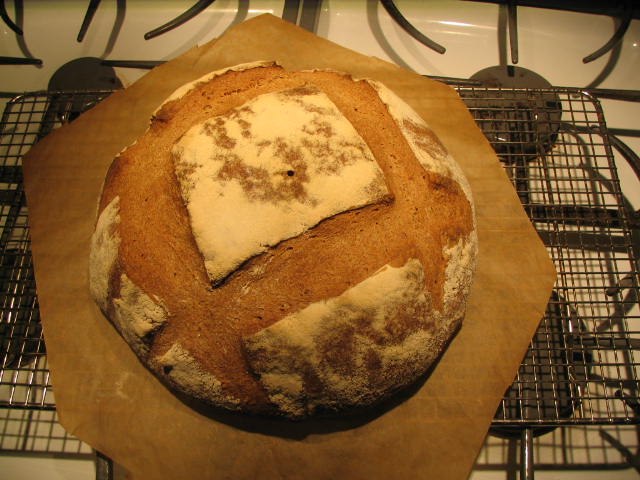Now that I figured out how to upload photos, here is another one. I have been baking this one a lot, mainly because it's easy to handle and make, my family likes it a lot, and it lasts a long time... Simply following BBA's formula for Poilane's Miche. I have a very feisty starter that helps out a lot I think. Anyone else tried this? How is the crumb in yours? I am curious...





Hi, hasimtug.
Nice miche!
I haven't made this one for a while. I've been using Hamelman's Miche, Pointe-à-Callière formula instead. When I made Reinhart's miche, my crumb looked pretty much like yours, though.
I generally have used KAF First Clear Flour for this bread. What do you use?
David
Thanks David. You know, it's a bit tough to know exactly what kind of flour I am using, if I want to explain in terms of what's used in the US. I am in Cyprus here, and there is only one kind of Turkish brand whole wheat flour- it has a protein content of about 12.5% with an ash content of 1.5%. That's what I use and I end up sifting most of the bran out of it. It seems to work... I like how flavors develop over time and this bread is so tasty when toasted.
Hazim
I think that Poilane is really beautiful....let me see if I have a photo....

My starter is made with unbleached white bread flour. I put a squirt of honey, and substituted milk half and half with water for the liquid. I'm sure I gave it a splash of olive oil also. I'm not sure how to continue writing after posting a photo; this is why I'm continuing here.
My starter is unbleached white flour too, but it's just water & flour... I bet having some milk make the bread more tender. I thought about adding such tenderizers but I am afraid the shelf-life will decrease... Thanks for sharing your photos. Nice crumb.
Hazimtug,
I like the look of your Miche. I especially like the shape after baking. When I tried this bread I can not get it to hold the height, it always ends up more flat. Both you and rainwater seem to have overcome that obstacle. Very nice.
Eric
Hi, Eric.
If you look at the pictures in BBA and the photo and text in Hamelman, you will see that these breads are meant to have a flat profile. Hazimtug's miche is very nice, but it is more spherical than most.
You can achieve this with a lower-hydration dough, good shaping and optimizing oven spring. I suspect that hazimtug's flour absorbed more water than First Clear would, so the dough was on the dry side - just a bit tacky, I would guess.
David
since I'm new to sourdough....about 3 months, I'm not an expert. I keep my starter aroun 75% hydration. I handle it like a wet dough. Hmmm....I don't have very strong small muscle groups, so everything as soon as it's mixed barely with a spoon in the bowl goes directly to the counter. I use the french slam, stretch, and fold method on my starter when I feed it until it is well mixed. After it's risen on the counter in it's plastic container, I take it out; slam, stretch, and fold a few times to degas and mix and then place in the refrigerator. My starter is typically slow to rise/ferment but has great oven spring and it usually springs upward.
p.s. I didn't use milk in my starter, but in the final dough. This bread seems to have a long shelf life...for me anyway.....but after the first day, I toast everything I make. Usually toast one side and leave one side soft.
I wish I had a large family so I could bake bread everyday and always serve fresh bread......
David- you are right. I was impressed that my bread was rising more than I observed in the pictures presented in the BBA. My first loaf (what you see in the pix) was on the drier side I guess, but recently, I can feel the dough getting slacker (tacky is the term?)- i.e., a bit softer due to higher hydration) and harder to handle, especially when shaping into a boule. Oven spring is still there... I guess it is still relatively on the dry side.
Rainwater- my starter is at ~100%, just like Reinhart recommends. It's been working just fine for me. In fact, I seem to prefer my starter over my other instant yeasty friends nowadays... My starter is either more reliable or it's just more potent than the instant yeast under the existing environmental factors (room temperature & humidity that is...). Yes, it is nice to have a big family to keep experimenting. When I try to explain the science though, it usually goes over their heads... They get it sometimes though. Fun, either way!
Hazim
Hi
It looks very good to me and I've been having problems with oven spring on a similar loaf from Daniel Leader's Local Breads. Are you following BBA's recipe exactly and are your dough's rising and proofing times similar to the recipe?
Yes, I am following the recipe exactly, except I am not sure if I am really using the WW flour that Reinhart is suggesting we use. I just use whatever is available in the market here and sift it to remove most of the bran. As you may know, bran can cut through gluten strands, hence it may have an effect on oven spring as well I would think. I did try not sifting once and the result was remarkable less oven spring compared to the sifted. And my proofing times are very similar as well. For the 4-hour long bulk fermentation at room temperature, I let the dough sit at room temperature even though it usually more than doubles- as Reinhart suggests for full flavor development.
Hope this helps... Thanks!
Hazim
Very very nice looking bread!
I think I'll have to try the BBA recipe next -
after making Poilane, I am feeling kind of empty.... need another project to keep me going, maybe a second Poilane will be it? :-)
Sally, when I went back to watch Eric's video I also read my comments - I had completely forgotten that the second time I made the loaf I proofed it in a parchment lined banneton and baked it in a preheated ss dutch oven. I also noted that it didn't spread as much as it did on the stone and the bottom crust was more to my liking, not almost burned. Made me all the more determined to try again, A.
I guess there are indeed many different ways to approach this bread - I think I'll either repeat this recipe exactly as I made it, but using the roaster pan just moistened with very hot water, or use the BBA recipe.
I am sure that the more practice, the better!
Mine did not spread that much, but now that I know the size of the loaf, I could try to bake it in a clay pot I have, with a lid. That could be interesting to try
could you point me to BBA's formula for Poilane's Miche? Is it in a book?
I was in Brussels last week and passed a few great bakerys there, but no miche...
Cheers,
Jw.
Jw.. the formula is in BBA book- The Bread Baker's Apprentice by Peter Reinhart. Sylvia